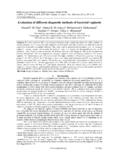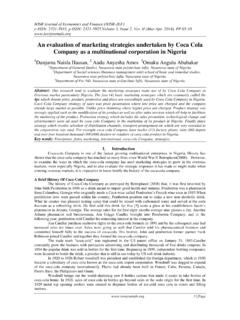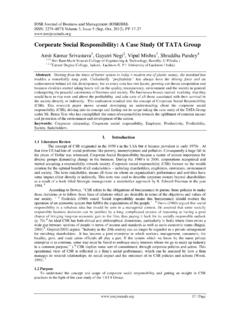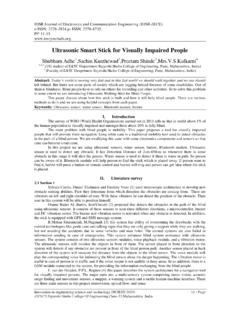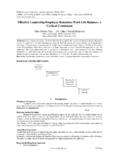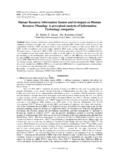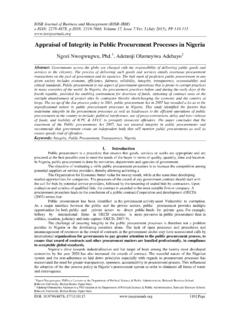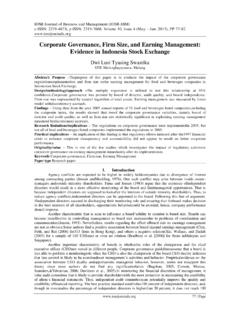Transcription of Automotive Diagnostics Communication Protocols Analysis ...
1 IOSR Journal of Electronics and Communication Engineering (IOSR-JECE). e-ISSN: 2278-2834,p- ISSN: 10, Issue 1, Ver. 1 (Jan - Feb. 2015), PP 20-31. Automotive Diagnostics Communication Protocols Analysis - KWP2000, CAN, and UDS. Muneeswaran. A, ECU Diagnostics Engineering, Dept. of Electric & Electronics, Renault Nissan Technology & Business Centre, Mahindra world city,Tamil Nadu, India Abstract:The increasing application of embedded electronic components in vehicles brings the need to use diagnostic systems for track and control of parameters. Development, industrial and after-sales are all fields thatuse diagnostic systems' help to execute their diagnostic system must, therefore, contain a protocol for connecting the diagnostic tools that the designers, testers and repairers use for checking the ECU's diagnosis information.
2 Each protocol might be suitable for only one diagnostic system and vehicle components and systems need a great amount of effort to implement protocol for one particular diagnostic system. However, there are many types of diagnostic systems defined by ISO and SAE depending on the type of systems and specific Diagnostics from the vehicle manufacturers. Moreover, under some conditions, the development time may more than double. Applying Communication Protocols such as KWP2000, CAN and UDS makes diagnostic device of vehicle network communicate to each other according Paper aims to present an overview about a fewcommunication Protocols for diagnostic and services, byshowing their specific tools and applications.
3 Index terms:Controller Area Network, International Standard Organization, Society of Automotive Engineers, OSI Layers, Keyword Protocol, Unified Diagnostics I. Introduction Diagnostic determines, verifies and classifies symptoms aiming to get an overall picture in finding the root cause of a problem in a car. The detection, Improvement and Communication strategies applied to abnormal operation of systems is monitored by Electrical and electronic devices. Therefore, the purpose ofDiagnostic is to identify the root cause of abnormal operation so a repair can be requirements for OEM. and supplier are defined by a common database which contains the functional diagnostic requirements, its implementation, development, specific dataconcerning to it and also its features.
4 Everyone must have a straight interface with product engineering, manufacturing,Aftersales and supplier. Applicationsof diagnostic can be classified for the following fields as OEM: Development in this process, correct functionality of the vehicle's components must be validated. Diagnostic subsystem then takes role at reading out ECU's internal information, and data such as sensor and actuator's values. Production the assembly plant uses the diagnostic system for transferring calibration data and software updates to the non-volatile memory of the ECUs, EOL programming and tests included. Aftersales in the operating vehicle, Diagnostics are mainly used for error detection.
5 Detected errors are stored to a persistent fault memory, and trouble codes are read out at the service station in order to make troubleshootingFeasible. In the development cycle of an Automotive system, diagnostic features can be employed in development, manufacturing and services stages. First of all, diagnostic specifications must take a common database to perform - such as ODX - in which change and data management, and diagnostic development tools should be defined. Diagnostic systems require that computer tools can access a Communication protocol and perform all diagnostic systems based on the diagnostic connector. II. Automotive Protocols A diagnostic protocol defines a set of conventions used for diagnostic Communication between a diagnostic device and an ECU in the vehicle.
6 Diagnostic Communication services should be defined in a way to meet development stages, manufacturing and services main characteristics of the following diagnostic Protocols and services will be investigated. They are all well-known and broadly used by OEM and suppliers at the market: 1) KWP2000 - Keyword Protocol 2000. 2) Diagnostics on CAN Protocol 3) UDS - Unified Diagnostic Services. DOI: 20 | Page Automotive Diagnostics Communication Protocols Analysis -KWP2000, CAN, and UDS. It will be presented a description of their characteristics and a comparative Analysis will be performed. In order to assist OEMs and suppliers for an overall view, some diagnostic tools used for development, test, validation and services will be introduced.
7 III. Diagnostic Communication Ofvehicle The Automobile has composed set of generic subsystems as: Power train, Chassis, Body, Communication Control and other related domains as Customers and Standards Automotive , the Systems are managed by Electrical and Electronics Components with Control of Software Standards of Automotive Embedded System Automotive Electronics, Electronic Control unit (ECU) is a generic term for an electronic device that can manage and control subsystems in the automobile. This approach is commonly defined by embedded control systems that demand method, process and tools for development. Fig 1 presents a block diagram and Architecture of an Engine ECU used to managing and controlling Automotive system.
8 It contains analog and Digital input/output signals, Serial Communication Control unit which is enable the interconnection between other Automotive System unit like Cluster, Airbag System, Switch module etc. Figure 1: Block Diagram and architecture of Engine ECU with input/output interfaces Types of ECU include Electronic/Engine Control Module (ECM), Power train Control Module (PCM), Transmission Control Module (TCM), Electronic Brake Control Module (EBCM), Suspension Control Module and other ones, allDefined and named by OEM (Original Manufacturer Equipment) according to its are cases when an assembly component incorporates several of the individual control modules.
9 For example: PCM is to manage Engine and Transmission. Fig 2 presents a block diagram at ECU Managing the Combustion shows the main input and output signals. Electrical requirements need to be in accordance to the automobile Environment inside the ECU. Figure 2: Engine electronic management with an ECU. In vehicle functions were realized able with electro-mechanical means or with discrete electronic components either not at all or only with disproportionately high complexity. In the mid of 1970's the development of integrated circuits in a wide range of applications and revolutionized Automotive Engineering. DOI: 21 | Page Automotive Diagnostics Communication Protocols Analysis -KWP2000, CAN, and UDS.
10 Until the beginning of the 1990's data were exchanged through point to point links in problems with weight, cost, complexity and reliability. Currently, some modern motor vehicles have up to 60 or more ECU's communicate via several Automotive bus systems, such as LIN, CAN, UDS, MOST, Flex Ray etc. with each other via Gateway Control such Automotive bus a network has managing the increasing of complexity of ECU's in vehicle has a challenge for OEM's and Automotive suppliers. Main tasks of the ECU fulfill its controlling their specific functionality in which measures and collects the data need to be perform its main tasks checking and filtering the main signals/ incoming signals.
